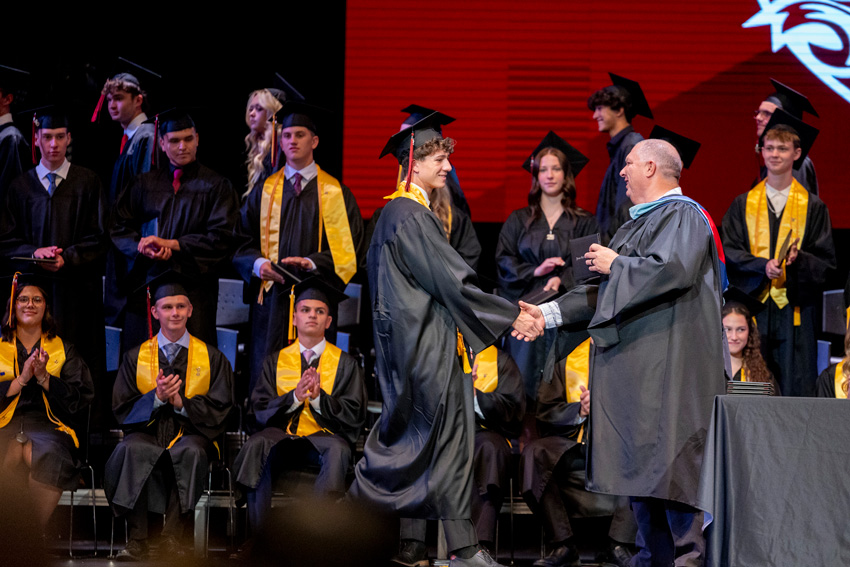For the past 23 years, teacher Sharon Scharf has taught FC students about the aspects of art and home economics (home ec.). In home ec class, Scharf focuses the first semester on food, but then switches the second semester to emphasize sewing, concentrating on clothing and textiles
According to the National Home Economics Standards there are 17 different areas of study, which Scharf trys to cover throughout the semester, but since time is limited not every area is covered. So, only a few basic subjects are covered such as dietetics and nutrition, fashion, apparel and textiles. To make sure every important subject is covered, Scharf creates a semester plan.
“During our second semester, we focus on the clothing and textiles area of study,” Scharf said. “The student learns life skills such as sewing on buttons, repairing hems, stain removal and laundry techniques, consumer purchasing, and reading labels to know what you are purchasing, to name a few.”
The overall purpose of home ec. is to prepare students for adult life and basic skills needed for the future. Scharf believes that preparation is an important part of the class and goes a bit more in-depth about what the student should take away from the class.
“Preparing students for living on their own is definitely one of the goals of this class.” Scharf said. “Preparing the student to be a productive, caring member of society (putting others first), being aware of our environment and how to care for it and learning to solve problems are some of the purposes of the class. Also, utilizing the knowledge you’ve learned in other classes such as math and science is a goal of this class.”
Senior Emily Daniel learns valuable life lessons in home ec. that she can carry with her into her adult life, like cooking assorted foods, she says.
“I learned how to cook various foods from different cultures and now I’m learning how to sew together clothes and follow a pattern to make various objects.” Daniel said. “As a girl I think it’s important for me to learn the basics of cooking and sewing for later on in life, so I’m really thankful that the school provides a class for this.”
Unlike Daniel, freshman Sabrina Henderson was not as excited for the change as some of her classmates.
“I was kind of disappointed because I’m really good at cooking and I really suck at sewing,” Henderson said. “So the switch has kind of been fun because of the pajama pants, but really hard because I suck at sewing; I cannot sow to save my life. I’m looking forward to going onto the next level and to learn knitting like beanies and all the new stuff like that.”
Generally, when students join a class like home ec. or art, they want to learn how to do a new thing. Scharf likes to teach new concepts to students, like why and how things work, especially in the first semester when focusing on food.
“I’m always excited to start first semester as I love to show students how to do things ‘from scratch’ in the kitchen.” Scharf said. “I love to teach them why things work the way they do, like gluten in bread. We learn food science and food production. We learn about different cultural food other than our own, and we learn to bless others with our culinary skills. The beginning of hospitality is food!”
According to Scharf, some of the skills she teaches students can easily spark interest and become hobbies for the individuals.
“I must admit, some of the things we learn and do can become addictive, such as cross stitch and needle point on knitting, but it’s better than sitting playing video games!” Scharf said. “I enjoy helping a student find their ‘strengths,’ and helping them expand them. They are all gifts from the Lord, be it clothing construction, beanie knitting, crazy quilt squares or any of many other options.”
Scharf says she enjoys second semester because it can bring out the more creative side of students and allows them to grow in their specific talents.
“I’m always excited about clothing and textiles.” Scharf said. “Not only does the student learn basic life skills as repairing your clothes and keeping them in good condition, but a student can learn a skill to bless others with; expand their creative gifts and create one-of-a kind garments and accessories they can be proud of.”
For more information about home ec., read the May 21, 2008 article, Baby blankets teach needlework, service. For photos about home ec., check out Student sewing and Beanie boys.







michael ogdon • Jan 27, 2012 at 12:02 am
The varsity volleyball team has certainly impressed me with the solid growth and improvements they’ve made this year. Essentially returning only two players from last year, this team has come together and really achieved some great results.